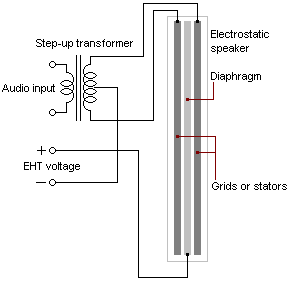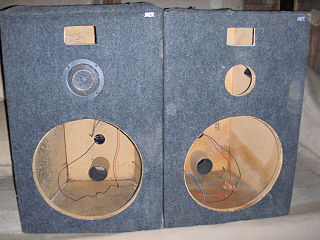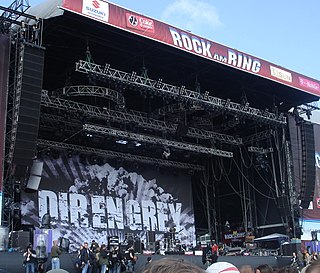
A subwoofer is a loudspeaker designed to reproduce low-pitched audio frequencies known as bass and sub-bass, lower in frequency than those which can be (optimally) generated by a woofer. The typical frequency range for a subwoofer is about 20–200 Hz for consumer products, below 100 Hz for professional live sound, and below 80 Hz in THX-certified systems. Subwoofers are never used alone, as they are intended to augment the low-frequency range of loudspeakers that cover the higher frequency bands. While the term "subwoofer" technically only refers to the speaker driver, in common parlance, the term often refers to a subwoofer driver mounted in a speaker enclosure (cabinet), often with a built-in amplifier.

A loudspeaker is an electroacoustic transducer, that is, a device that converts an electrical audio signal into a corresponding sound. A speaker system, also often simply referred to as a "speaker" or "loudspeaker", comprises one or more such speaker drivers, an enclosure, and electrical connections possibly including a crossover network. The speaker driver can be viewed as a linear motor attached to a diaphragm which couples that motor's movement to motion of air, that is, sound. An audio signal, typically from a microphone, recording, or radio broadcast, is amplified electronically to a power level capable of driving that motor in order to reproduce the sound corresponding to the original unamplified electronic signal. This is thus the opposite function to the microphone, and indeed the dynamic speaker driver, by far the most common type, is a linear motor in the same basic configuration as the dynamic microphone which uses such a motor in reverse, as a generator.

Audio feedback is a special kind of positive loop gain which occurs when a sound loop exists between an audio input and an audio output. In this example, a signal received by the microphone is amplified and passed out of the loudspeaker. The sound from the loudspeaker can then be received by the microphone again, amplified further, and then passed out through the loudspeaker again. The frequency of the resulting sound is determined by resonance frequencies in the microphone, amplifier, and loudspeaker, the acoustics of the room, the directional pick-up and emission patterns of the microphone and loudspeaker, and the distance between them. For small PA systems the sound is readily recognized as a loud squeal or screech. The principles of audio feedback were first discovered by Danish scientist Søren Absalon Larsen, hence the name Larsen effect.

A mid-range speaker is a loudspeaker driver that reproduces sound in the frequency range from 250 to 2000 Hz. It is also known as a squawker.

An electrostatic loudspeaker (ESL) is a loudspeaker design in which sound is generated by the force exerted on a membrane suspended in an electrostatic field.
Directional Sound refers to the notion of using various devices to create fields of sound which spread less than most (small) traditional loudspeakers. Several techniques are available to accomplish this, and each has its benefits and drawbacks. Ultimately, choosing a directional sound device depends greatly on the environment in which it is deployed as well as the content that will be reproduced. Keeping these factors in mind will yield the best results through any evaluation of directional sound technologies.

A sound reinforcement system is the combination of microphones, signal processors, amplifiers, and loudspeakers in enclosures all controlled by a mixing console that makes live or pre-recorded sounds louder and may also distribute those sounds to a larger or more distant audience. In many situations, a sound reinforcement system is also used to enhance or alter the sound of the sources on the stage, typically by using electronic effects, such as reverb, as opposed to simply amplifying the sources unaltered.
In the field of acoustics, a diaphragm is a transducer intended to inter-convert mechanical vibrations to sounds, or vice versa. It is commonly constructed of a thin membrane or sheet of various materials, suspended at its edges. The varying air pressure of sound waves imparts mechanical vibrations to the diaphragm which can then be converted to some other type of signal; examples of this type of diaphragm are found in microphones and the human eardrum. Conversely a diaphragm vibrated by a source of energy beats against the air, creating sound waves. Examples of this type of diaphragm are loudspeaker cones and earphone diaphragms and are found in air horns.
Loudspeaker acoustics is a subfield of acoustical engineering concerned with the reproduction of sound and the parameters involved in doing so in actual equipment.

A bass reflex system is a type of loudspeaker enclosure that uses a port (hole) or vent cut into the cabinet and a section of tubing or pipe affixed to the port. This port enables the sound from the rear side of the diaphragm to increase the efficiency of the system at low frequencies as compared to a typical sealed- or closed-box loudspeaker or an infinite baffle mounting.
Acoustic absorption refers to the process by which a material, structure, or object takes in sound energy when sound waves are encountered, as opposed to reflecting the energy. Part of the absorbed energy is transformed into heat and part is transmitted through the absorbing body. The energy transformed into heat is said to have been 'lost'.

Acoustic resonance is a phenomenon in which an acoustic system amplifies sound waves whose frequency matches one of its own natural frequencies of vibration.

A dipole speaker enclosure in its simplest form is constructed by mounting a loudspeaker driver on a flat panel. The panel may be folded to conserve space.

A loudspeaker enclosure or loudspeaker cabinet is an enclosure in which speaker drivers and associated electronic hardware, such as crossover circuits and, in some cases, power amplifiers, are mounted. Enclosures may range in design from simple, homemade DIY rectangular particleboard boxes to very complex, expensive computer-designed hi-fi cabinets that incorporate composite materials, internal baffles, horns, bass reflex ports and acoustic insulation. Loudspeaker enclosures range in size from small "bookshelf" speaker cabinets with 4-inch (10 cm) woofers and small tweeters designed for listening to music with a hi-fi system in a private home to huge, heavy subwoofer enclosures with multiple 18-inch (46 cm) or even 21-inch (53 cm) speakers in huge enclosures which are designed for use in stadium concert sound reinforcement systems for rock music concerts.

An acoustic transmission line is the use of a long duct, which acts as an acoustic waveguide and is used to produce or transmit sound in an undistorted manner. Technically it is the acoustic analog of the electrical transmission line, typically conceived as a rigid-walled duct or tube, that is long and thin relative to the wavelength of sound present in it.

A line array is a loudspeaker system that is made up of a number of usually identical loudspeaker elements mounted in a line and fed in phase, to create a near-line source of sound. The distance between adjacent drivers is close enough that they constructively interfere with each other to send sound waves farther than traditional horn-loaded loudspeakers, and with a more evenly distributed sound output pattern.
The Voigt pipe is a type of loudspeaker enclosure that embodies a combination of transmission line, ported enclosure and horn characteristics. It is highly regarded by some speaker designers, as evidenced by established manufacturers such as Castle. Due to its relatively high efficiency the design is frequently employed in full-range loudspeaker designs.
Acoustic quieting is the process of making machinery quieter by damping vibrations to prevent them from reaching the observer. Machinery vibrates, causing sound waves in air, hydroacoustic waves in water, and mechanical stresses in solid matter. Quieting is achieved by absorbing the vibrational energy or minimizing the source of the vibration. It may also be redirected away from the observer.

An electrodynamic speaker driver, often called simply a speaker driver when the type is implicit, is an individual transducer that converts an electrical audio signal to sound waves. While the term is sometimes used interchangeably with the term speaker (loudspeaker), it is usually applied to specialized transducers which reproduce only a portion of the audible frequency range. For high fidelity reproduction of sound, multiple loudspeakers are often mounted in the same enclosure, each reproducing a different part of the audible frequency range. In this case the individual speakers are referred to as drivers and the entire unit is called a loudspeaker. Drivers made for reproducing high audio frequencies are called tweeters, those for middle frequencies are called mid-range drivers, and those for low frequencies are called woofers, while those for very low bass range are subwoofers. Less common types of drivers are supertweeters and rotary woofers.
A transmission line loudspeaker is a loudspeaker enclosure design which uses the topology of an acoustic transmission line within the cabinet, compared to the simpler enclosures used by sealed (closed) or ported designs. Instead of reverberating in a fairly simple damped enclosure, sound from the back of the bass speaker is directed into a long damped pathway within the speaker enclosure, which allows far greater control and use of speaker energy and the resulting sound.












